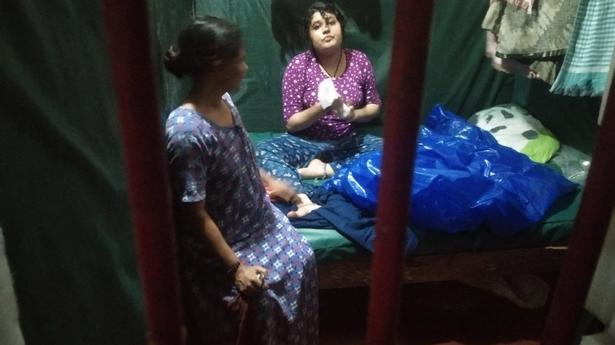Victims still miffed over the government’s perceived delay in treatment and rehabilitation
Victims still miffed over the government’s perceived delay in treatment and rehabilitation
In the early-evening darkness, when rain poured down again in the hilly neighbourhood of Mavungal, a few kilometre from Kanhangad municipality in Kasaragod district of Kerala, K. Praveena held her 15-year-old son close to her chest after sensing his nervousness listening to the pitter-patter sound.
As she wrung her hands piteously around him, the 38-year-old music teacher sounded worried about the future of her son born with cerebral palsy, a victim of the lethal Endosulfan pesticide, which was sprayed across plantations in the district earlier.
“His behaviour has changed with age. He often turns aggressive at the slightest disturbance,“ said Ms. Praveena, who quit her career at a school in Madikai grama panchayat to take care of the child when her husband abandoned them long ago.
Hers is not an isolated case of the appalling condition of families of Endosulfan victims residing near the cashew plantations in Kasaragod. Of the 3,704 among them, 102 are bedridden, 326 mentally challenged, 201 are physically disabled, 119 wrecked by cancer while 2,966 others fall in the residual category.
The recent Supreme Court order pulling up the Kerala government for delaying the compensation to the victims has rekindled the hopes of their families. “Yes, it is a relief for us after a long wait for justice,“ said Ms. Praveena, who makes a living from teaching music online. In 2017, the apex court had ordered that the State government pay ₹5 lakh each to the victims in three months. Only eight victims have been paid compensation since then.
Despite the court rulings, these families are miffed over the perceived delay in getting medical facilities, treatment, or rehabilitation to cope with life-long health issues arising out of the effects of Endosulfan. “We are forced to depend on hospitals with specialist care facilities in nearby Mangaluru in Karnataka,“ says Rajeswari, who lives with her 21-year-old mentally-challenged daughter and her nonagenarian mother in a run-down area at Chengala grama panchayat.
Her husband too walked out of their marriage following the birth of their daughter. With financial support from local people, Ms. Rajeswari now manages to attend to her daughter’s medical needs.” Sometimes, I have no choice but to chain her with shackles in a room, when she gets violent,“ she said.
Others like S. Pravitha, however, desperately yearns for a BUDS school, a free and open special institution, set up by the government for mentally challenged children of poor families in Kerala. “ Such schools should be opened in every grama panchayat to help our children, ‘‘ she felt.
Herself a victim of Endosulfan exposure, T.V. Sajitha, a resident of Cheemeni, is suffering from cancer and chronic kidney disease. “ Kasaragod requires a palliative care hospital as well as a super-specialty hospital for treating us, “ she said, feeling relieved after the Supreme Court order.
Based on a report submitted by the National Institute of Occupational Health, the National Human Rights Commission recommended to the State government in 2010 to establish a Centrally sponsored Palliative Care Hospital in Kasaragod. “ Had the recommendations been implemented then, these patients, about 6,700 of them spread over 11 villages, would not have to go through this ordeal, “ M.A. Rahman, an anti-Endosulfan activist, said.
K.K. Ashokan, secretary, Confederation of Endosulfan Victims Right Collective, accused the authorities of delaying the completion of a rehabilitation village in 25 acres at Muliyar grama panchayat. “ Now these hapless patients have to run from primary health centres to the district hospital to government-sponsored Neethi medical stores for treatment and purchase of medicines, “ he said.
After confirming the deadly effects of the pesticide for several decades, the government finally banned its use in 2005. “ Still the victims crawl beneath the lid of darkness with long-term health consequences, including cancer and genetic damage, “ Mr.Ashokan lamented.







